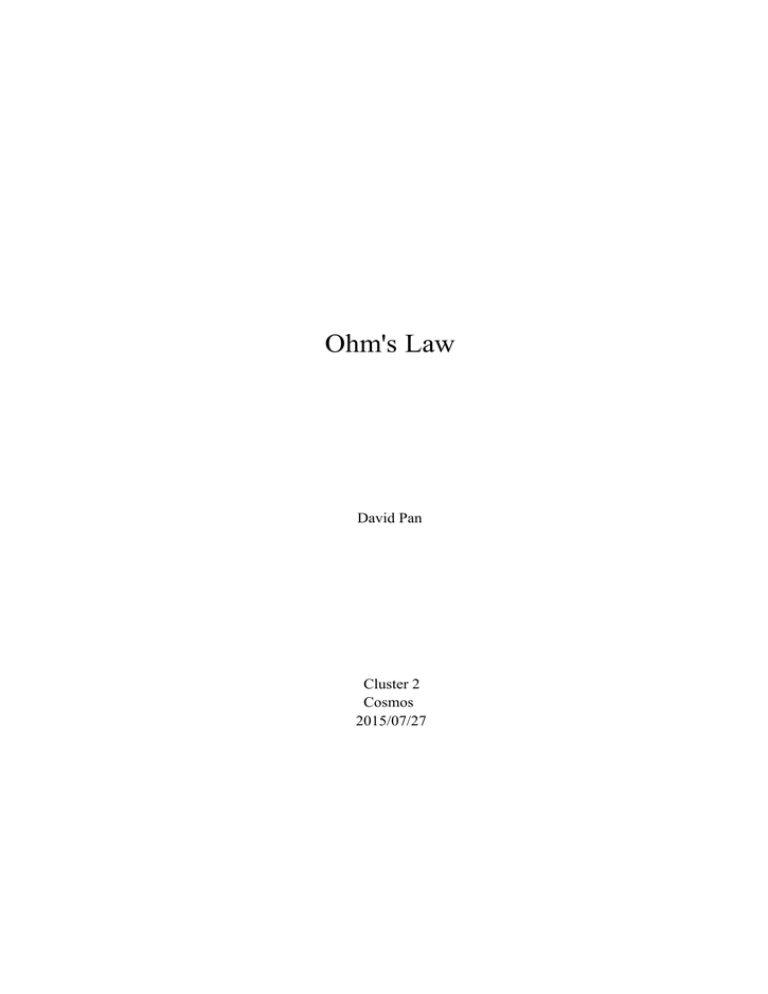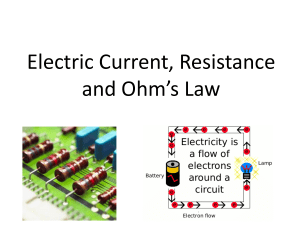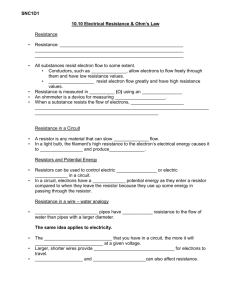David Pan_OhmGÇÿs law _research paper
advertisement

Ohm's Law David Pan Cluster 2 Cosmos 2015/07/27 Ⅰ. Abstract The objective of several Ohm's experiments is trying to find the relationship between three variables in the circuit. At first, Ohm does several experiments in order to find what determine the resistance of circuit. After finding what determine the resistance of circuit, Ohm varies three variables of circuit individually and finally establishes the right law about the relationship between three variables in circuit. That is, the current through a conductor between two points is directly proportional to the potential difference across the two points and inversely proportional to the resistance of the conductor. Ⅱ. Introduction In 1775, Henry Cavendish, of England, the first person who tries to find the relationship between voltage, current and resistance, did a experiment about current and resistance. He varies the length of a tube in order to vary the resistance and uses his body to sense the strength of current because of his own body. He concludes that higher the resistance, lower the current in the circuit. In 1800, Volta invented one of the most important things in electrical study. That is the voltaic piles. Voltaic piles provide relatively stable and constant current, which enable scientists much more conveniently to study electricity. In early eighteen century, Orsted discovered the phenomenon that wire which has electricity passes through will form a magnetic field around it. This discovery enlighten scientist and they make a new and rudimentary equipment which can measure the strength of current. Later, scientists improved this equipment and it became a normal equipment we always use to measure the current strength now-galvanometer. Using this equipment, scientists can study the electricity more easily and humans are more close to the reality of electricity. In 1820, Sir Humphry Davy did a experiment about the relationship between the resistance of a conductor, the length of the conductor and the cross-section of the conductor. He concluded that wires having the same ratio of length to cross-section had the same resistance, which accords to part Ⅱ of Ohm's law. For centuries, these pioneers collected so many data about the relationship between current, voltage and resistance but they still did not know and define some variables and units. The investigation of Ohm perfectly solves these problems and establish a law which we can use to predict the behavior of electricity. Ⅲ. Material and Methods Experiment 1 A. Material 1. voltaic piles 2. conductor which have different length 3. a resistor 4. torsion balance B. Methods In this experiment, Ohm connects voltaic piles, and a resistor with fixed resistance in series. He first connects a shortest conductor to the circuit and then he use torsion balance to measure the force of current. Then he replace the shortest conductor with other longer conductor and use torsion balance to measure the force of current. At last, compare force strength respectively to conductors' length. Experiment 2 A. Material 1. Voltaic pile 2. Galvanometer 3. Wires 4. Resistors with different material, cross-section and length B. Methods Ohm uses a voltaic pile which has fixed voltage. Then, he connects different resistors with different material, cross-section and length and then he uses a galvanometer to measure the current in the circuit with different resistor. Experiment 3 A. Material 1. Voltaic pile 2. Galvanometer 3. Wires 4. 2 conductors with same cross-section and length but one is circular while the other is flat. B. Methods Ohm uses a voltaic pile to provide same voltage on two conductors with same cross-section and length but one is circular while the other is flat. Meanwhile, he uses galvanometer to measure the current in the circuit Experiment 4 A. Material 1. Thermocouple( a more stable electricity generator compared to voltaic pile) 2. Torsion Balance 3. Wires 4. conductors with different length B. Method In this experiment, Ohm uses thermocouple instead of voltaic piles. Thermocouple is a more stable electricity source and we can change the voltage through varying the temperature difference of the thermocouple. This experiment is really similar to the first experiment. First, Ohm connects a shortest conductor to the thermocouple and he uses torsion balance to measure the force of current which can show the strength of current. Then he uses same way to measure the current passes through other conductors with different length. Then, he decreases the temperature difference between two ends of thermocouple in order to decrease the voltage it provides. Then, he uses same method to measure the current pass through different conductors again. Ⅳ. Result A. Experiment 1 In this experiment, the force of current decreases as the length of conductor increases. Also the data Ohm recorded accords the graph v=0.41log(1+X). B. Experiment 2 In this experiment, Ohm finds that the current passes through resistors which have different materials but same length and cross-section is different. However, he also finds that current passes through resistors which have same material and same ratio of length to cross-section is same. C. Experiment 3 In this experiment, Ohm finds that current pass through two conductors is same when voltage on two resistors is same cross-section and length. Therefore, the current is same because experiment 1 has proved that. Thus, we can conclude that current is uniformly distributed throughout the section. D. Experiment 4 In this experiment, the force of current decrease as the length of conductors increases. After decreasing the temperature difference between two ends, which means decreasing the potential difference between two ends, the force of current still decreases as the length of conductors increases. However, the force of current after decreasing the temperature is smaller than the force of current before decreasing the temperature. Ⅴ. Discussion In the experiment 1,Because the force of current decrease, Ohm assumes that the current also decreases. Thus, Ohm concludes that the current of circuit is inversely proportional to the length of conductor. Also, analyzing his data, he implies that the loss of potential difference can be formulated as v=m log(1+x/a), where a depends on the length of conductor, m is the normal force and x is the resistance of external resistor. In the experiment 2, resistors which have different materials but same length and cross-section have different current pass through while the voltage is same. It infers that the resistance of these resistors is different. In addition, resistors which have same material and same ratio of length to cross-section have same current pass through while the voltage is same. It infers that these resistors have same resistance. Experiment 1 indicates that the type of material is one of the variables that determines the resistance of this material. Furthermore, the resistance of the conductor is directly proportional to the ratio of length to cross-section. In the experiment 3, although one resistor is circular and the other is flat, current pass through two resistors is same when the voltage is same. The voltage on two resistors is same and two resistors have same sum of area of cross-section. Therefore, Ohm concludes that the current is uniformly distributed in the conductor instead of what people believed before that the electricity on the surface of the conductor. In the experiment 4, the force of current decreases as the voltage deceases, which means the current decreases as the voltage decreases. Also, the force of current decreases as the length of conductors increases, which means that the current decreases as the length of conductor increases. Thus, Ohm conclude that the current of a circuit is directly proportional to the voltage of the circuit and is inversely proportional to the length of conductor Ⅵ. Conclusion Through analyzing the data Ohm collects from the previous experiment, Ohm can derive the formula to calculate the resistance of a resistance. In experiment 1 and 4, Ohm has concluded that the resistance of a resistors is directly proportional to the length of the resistor. In experiment 2, Ohm knows that the current uniformly distributed in the resistor. In addition, experiment 1 proves that the resistance of the resistor is proportional to the ratio of length of resistor to the cross-section of resistor, which means the resistance of resistor is inversely proportional to the cross-section area. What's more, in experiment 1 Ohm knows that type of material also will determine of resistance of conductor.Thus, Ohm mixes these three finding into one formulaR=ρ(L/A). In the experiment 4, Ohm also gradually understands that current is directly proportional to the voltage of the circuit. After knowing that the resistance of resistor is directly proportional to the length of resistor, Ohm can also conclude that current is inversely proportional to the resistance of resistor since in experiment 4, current decrease as the length of conductor increase, which means the resistance increases. Ohm then mix these two conclusion into one formula-I=V/R. The establishment of Ohm's law shows people a new understanding of electricity and it indicates that people know more about electricity. People can use this law to control electricity in some extent. Ⅶ. References John C. Shedd and Mayo D. Hershey. "The History of Ohm's Law". Popular Science. Dec.1913. July 29. 2015 . Bonnier Corporation. Keithley Joseph F. "The Story of Electrical and Magnetic Measurements: From 500 BC to the 1940s". Institute of Electrical and Electronics Engineering. 1999. July 29. 2015. Timbie H. William. "Elements of Electricity". Basic Electricity for Communication. Fourth Edition. Massachusetts Institute of Technology. 1910. July 29. 2015 Robert A. Millikan and E. S. Bishop. "Elements of Electricity". American Technical Society. 1917. July 29. 2015. G. S. Ohm. "Die galvanische Kette, mathematisch bearbeitet". 1827. July 29. 2015. Griffiths, David J. "Introduction to electrodynamics". Third Edition. Prentice Hall. 1999. July 29. 2015. Ⅸ. Appendix Graph about data of experiment 1 Graph show the accuracy of measurement in experiment 4







